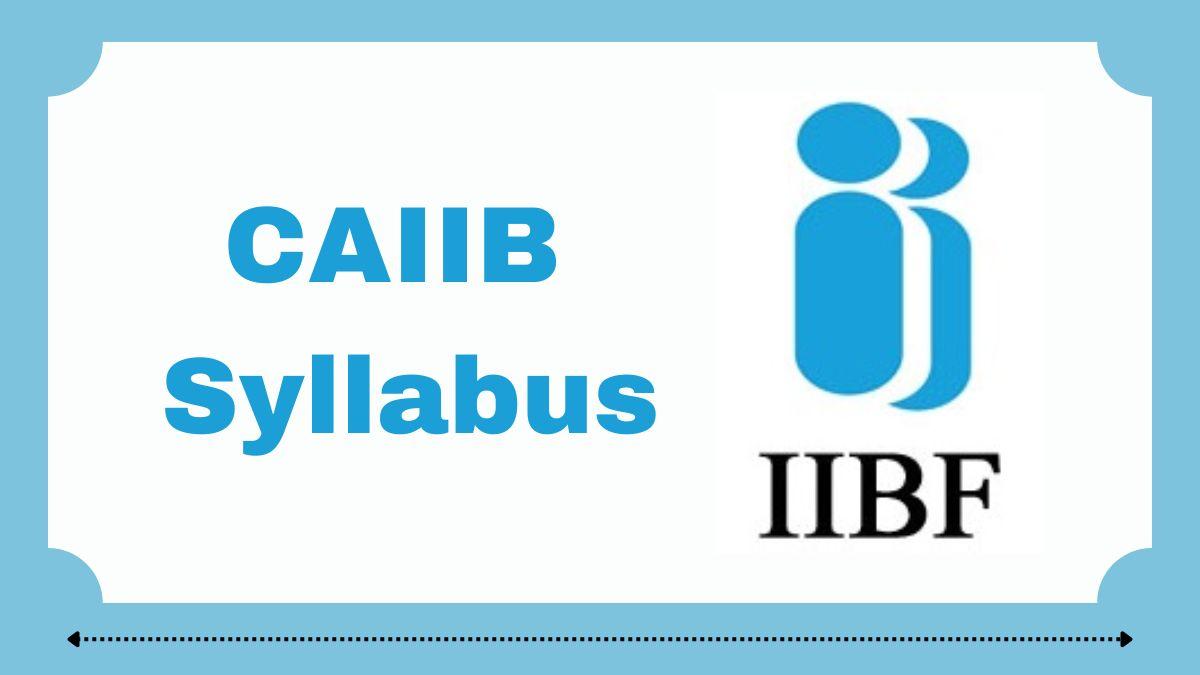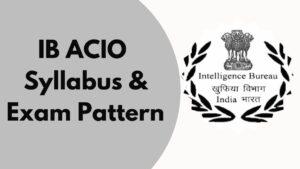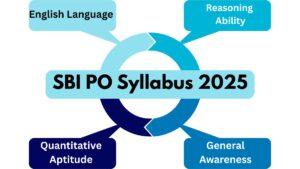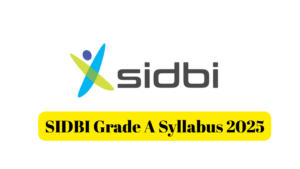Table of Contents
The Indian Institute of Banking & Finance (IIBF) has released the CAIIB Exam Date 2025 for November cycle. Candidates who are planning to appear for the CAIIB exam for this session must be well aware of the CAIIB Syllabus 2025 and Exam Pattern, which includes the compulsory and elective subjects. The syllabus will help the candidates to create a preparation strategy to appear in the examination.
CAIIB Syllabus 2025
As per the CAIIB 2025 Exam Pattern, the question paper of the online written exam will have 100 questions for 100 Marks. There will be no deduction for giving the wrong answer. For the ease of aspirants, a direct link is provided below from where they can download the CAIIB Syllabus. The syllabus is built in such a manner that it will help to improve concept-based skills among the aspirants who are willing to appear for the CAIIB Exam.
In this article, we will provide the details of the CAIIB 2025 Syllabus and exam pattern. The following are the topics that will be covered under the CAIIB Exam:
Compulsory Paper
- Paper 1: Advanced Bank Management(ABM)
- Paper 2: Bank Financial Management(BFM)
- Paper 3: Advanced Business and Financial Management (ABFM)
- Paper 4: Banking Regulations and Business Laws (BRBL)
Elective Paper
- Rural Banking
- Human Resources Management
- Risk Management
- Central Banking
- Information Technology and Digital Banking
CAIIB Exam Date 2025 Out- Click to Check
CAIIB Exam Pattern 2025
It is important for the candidates to get familiar with the CAIIB Exam Pattern 2025 as it is the complete structure of the examination. It includes the marking scheme, subjects, number of questions, and marks. There are 100 questions and 100 marks in each subject which the candidates need to answer.
| CAIIB Exam Pattern 2025 | |||
| Subjects | No. of Questions | Marks | Duration |
| Advanced Bank Management(ABM) | 100 | 100 | 2 hour |
| Bank Financial Management (BFM) | 100 | 100 | 2 hour |
| Advanced Business and Financial (ABFM) Management | 100 | 100 | 2 hour |
| Banking Regulations and Business Laws (BRBL) | 100 | 100 | 2 hour |
| Elective Paper (Any One) | 100 | 100 | 2 hour |
The questions that will be asked in the examination will be related to the following points.
- Knowledge testing
- Problem-solving
- Conceptual grasp
- Case analysis
- Analytical/ logical exposition
CAIIB Syllabus 2025 for Compulsory Papers
There are two papers under the Compulsory Paper section, and the details of the CAIIB Syllabus 2025 are provided in the points below.
Paper 1: Advanced Bank Management(ABM)
There are 4 modules in paper 1 (Advanced Bank Management ), given below:
- Module A: Statics
- Module B: Human Resource Management
- Module C: Credit Management
- Module D: Compliance in Banks & Corporate Governance
Module A: Statistics
The topics included in the Module A has been mentioned in the table mentioned in the table given below.
| Topics | Sub-Topics |
| Definition of Statistics, Importance & Limitations & Data Collection, Classification & Tabulation |
|
| Sampling Techniques |
|
| Measures of Central Tendency & Dispersion, Skewness, Kurtosis |
|
| Correlation and Regression |
|
| Time Series |
|
| Theory of Probability |
|
| Estimation |
|
| Linear Programming |
|
| Simulation |
|
Module B: Human Resource Management
The details of the Human Resource Management have been mentioned below for the candidates.
| Topics | Sub-Topics |
| Fundamentals of Human Resource Management |
|
| Development of Human Resources |
|
| Human Implications of Organizations |
|
| Employee Feedback and Reward System |
|
| Performance Management |
|
| Conflict Management and Negotiation |
|
| HRM and Information Technology |
|
Module C: Credit Management
The details of the topics and subtopics for credit management have been given in the table below.
| Topics | Sub-Topics |
| Overview of Credit Management |
|
| Analysis of Financial Statements |
|
| Working Capital Finance |
|
| Term Loans |
|
| Credit Control and Monitoring |
|
| Risk Management and Credit Rating |
|
| Restructuring/Rehabilitation and Recovery |
|
| Resolution of Stressed Assets under Insolvency and Bankruptcy Code 2016 |
|
Module D: Compliance in Banks & Corporate Governance
The topics and subtopics for compliance in Banks and Corporate Governance have been mentioned in the table given below.
| Topics | Sub-Topics |
| Compliance Function in Banks |
Compliance Policy; Compliance Principles
Process and Procedures Compliance Programme Scope of Compliance Function Role & Responsibilities of Chief Compliance Officer (CCO) |
| Compliance Audit |
Role of Risk-Based Internal Audit and Inspection
Reporting Framework and Monitoring Compliance Disclosure Requirements Accounting Standards Disclosures under Listing Regulations of SEBI |
| Compliance Governance Structure |
Organisational Structure
Responsibility of the Board and Senior Management Compliance Structure at the Corporate Office Functional Departments Compliance Structure at Field Levels Internal Controls and Their Importance Framework for Identification of Compliance Issues and Compliance Risks Compliance Issues Compliance Risk Inherent Risk and Control Risk Independent Testing and Effective Audit Programme Reporting Framework and Monitoring Compliance Role of Inspection and Audit Loan Review Mechanism/Credit Audit |
| Compliance Culture and GRC Framework |
How to Create a Compliance Culture Across the Organisation
Governance, Risk and Compliance (GRC) Framework Benefits of an Integrated GRC Approach Whistleblower Policy The Components of a Whistleblower Policy Reasons for Compliance Failures |
| Compliance Function and Role of CCO in NBFCs |
Framework for Scale-Based Regulation for Non-Banking Financial Companies
Transition Path: Framework for Compliance Function and Role of Chief Compliance Officer in Non-Banking Financial Companies in Upper Layer and Middle Layer (NBFCUL & NBFCML) |
| Fraud and Vigilance in Banks |
Definition of Fraud
Definition of Forgery Areas in which Frauds are committed in Banks Banking and Cyber Frauds Fraud Reporting and Monitoring System Vigilance Function in Banks RBI Guidelines for Private Sector and Foreign Banks |
Paper 2: Bank Financial Management (BFM)
Module A: International Banking
Exchange Rates and Forex Business:
- Foreign Exchange – Definition and Markets
- Factors Determining Exchange Rates
- Exchange Rate Mechanism
- Foreign Exchange Dealing Room Operations
- Derivative Products
- RBI / FEDAI Guidelines;
- Foreign Exchange Arithmetic – Concepts and Examples
Liberalized Remittance Scheme (LRS) and other Remittance Facilities for Residents:
- Capital Account Transactions and Current Account Transactions
- Key Sections under FEMA vis-à-vis Liberalized Remittance Scheme
- Permissible/Non-permissible Remittances under LRS
- Operational Guidelines
- Remittances under LRS for Current Account Transactions
- Tax Collected at Source (TCS)
- LRS vis-à-vis Capital Account Transactions
- Reporting Requirements under LRS
Correspondent Banking and NRI Accounts:
- Correspondent Banking – Accounts and other Services
- Nostro,
- Vostro and Loro Accounts
- Electronic Modes of Transmission/Payment Gateways – SWIFT
- CHIPS
- CHAPS
- RTGS
- NRI Banking
- NRI accounts – Rupee and Foreign Currency Accounts
- Facilities for NRIs
- Advances to Non-Residents against Non-Resident Deposits
- Housing Loans to Non-Resident Indians
Documentary Letters of Credit:
- Definition of Letter of Credit
- Types of Letters of Credit: Operations of Letters of Credit
- UCP 600 and Important Articles
- Liabilities, Responsibilities, and Rights of the Parties; Documents under LC – Scrutiny, Crystallization, Follow-up for Bills under LC, and Safeguards for Banks
- Risks Relating to LC Transactions
- Standby Letter of Credit (Similar to Guarantees)
- Uniform Rules for Bank-to-Bank Reimbursements (URR–725)
- International Standard Banking Practice – 745 (ISBP 745)
- Incoterms; Case Studies, Facilities for Exporters and Importers, Exchange and Trade Control Guidelines for Exporters
- Facilities for Exporters
- Export Finance
- Gold Card Scheme for Exporters
- Export Data Processing and Monitoring System (EDPMS)
- Factoring and Forfaiting; Exchange and Trade Control Guidelines for Importers
- Import Finance
- Import Data Processing and Monitoring System (IDPMS)
- Trade Credit – Supplier’s Credit and Buyer’s Credit
- Case Study on Export Finance
External Commercial Borrowings and Foreign Investments in India:
- External Commercial Borrowings – Concepts
- ECBs – Other Operational Concepts; Reporting Requirements
- Conversion of ECB into equity
- Foreign Investments; Key Concepts
- Eligible Foreign Investors
- Eligible Investee Entities
- Eligible Investment Instruments;
- Prohibited Sectors
- Rules Governing Pledge of Shares
- Operational Guidelines
- Snapshot of Non-Debt Instruments (NDI) Rules
- List of Documents for the Obtention of Foreign Investments
- List of Documents for Refund of Foreign Investments,
Risks in Foreign Trade – Role of ECGC:
- Definition of Risk and Risks in International Trade
- Country Risk
- Export Credit Insurance in International Trade
- ECGC Role and Products; ECGC Policies
- ECGs’ Products for Banks
- Other Aspects Relating to ECGC Policies and Guarantees
- Some of the Common “To Do Points” under ECGC Policies
- Claims Role of EXIM Bank, Reserve Bank of India, Exchange Control in India – FEMA
- FEDAI and Others EXIM Bank – Role, Functions and Facilities
- Reserve Bank of India – Role and Exchange Control Regulations in India
- Foreign Exchange Management Act (FEMA) 1999
- Role of FEDAI and FEDAI Rules
Short Notes on Other Topics:
- ECB and ADR/GDRs and FCCB
- International Financial Service Centres (IFSC), GIFTCity: Scope of IFSC in India
- Opportunities at Gift City
- Guidelines relating to the setting up of IFSC Banking Units (IBUs)
- Role of IFSCA
- Regulatory Framework
- Permissible Activities at IBUs
- Relaxations for the FPI (Foreign Portfolio Investors) Entities at GIFT City Technology in International Banking
- Introduction to Digitization in International Banking – An Overview
- Evolution of Technology in International Banking
- Benefits and Limitations of Technology in International Banking
- Digital Platforms in International Banking
- FINTECH and the evolution of FINTECH in International Banking
- Delivery channels under FINTECH in International Banking
- Sample Process of International Trade Using Blockchain Technology
- Challenges in FINTECH.
Module B: Risk Management
Risk and Basic Risk Management Framework:
- What is Risk? Linkages among Risk, Capital, and Return
- Why Risk Management?
- Basic Risk Management Framework
Risks in the Banking Business:
- Risk Identification in Banking Business
- The Banking Book
- The Trading Book
- Off-Balance Sheet Exposures
- Banking Risks – Definitions
Risk Regulations in the Banking Industry:
- Regulation of Banking Industries – Necessities and Goals
- The Need for Risk-based Regulation in a Changed World Environment
- Basel I: The Basel Capital Accord
- 1996 Amendment to Include Market Risk; Basel II Accord – Need and Goals
- Basel II Accord
- Towards Basel III
- Capital Charge for Credit Risk
- Credit Risk Mitigation
- Capital Charge for Market Risk
- Capital Charge for Operational Risk; Pillar 2 – Supervisory Review Process
- Pillar 3 – Market Discipline
- Capital Conservation Buffer; Leverage Ratio
- Countercyclical Capital Buffer
- Systemically Important Financial Institutions (SIFIs)
- Risk-Based Supervision (RBS)
Market Risk:
- Market Risk – Concept
- Market Risk in Banks
- Market Risk Management Framework
- Organisation Structure
- Risk Identification
- Risk Measurement
- Risk Monitoring and Control
- Risk Reporting
- Managing Trading Liquidity
- Risk Mitigation,
Credit Risk:
- General
- Credit Risk Management Framework
- Organisation Structure
- Risk Identification
- Risk Measurement
- Credit Risk Control and Monitoring
- Credit Risk Policies and Guidelines at Transaction Level
- Credit Control and Monitoring at Portfolio Level
- Active Credit Portfolio Management
- Controlling Credit Risk through Loan Review Mechanism (LRM)
- Credit Risk Mitigation
- Securitisation
Credit Derivatives (CDs), Operational Risk and Integrated Risk Management:
- Operational Risk – General
- Operational Risk – Classification
- Operational Risk Classification by Event Type – Definitions
- Operational Risk Management Practices; Management Overview and Organisational Structure
- Processes and Framework
- Risk Monitoring and Control Practices
- Operational Risk Qualification
- Operational Risk Mitigation
- Scenario Analysis
- Integrated Risk Management
- The Necessity of Integrated Risk Management
- Integrated Risk Management – Challenges
- Integrated Risk Management – Approach,
Liquidity Risk Management:
- Liquidity Risk Management – Need & Importance
- Potential Liquidity Risk Drivers
- Types of Liquidity Risk
- Principles for Sound Liquidity Risk Management
- Governance of Liquidity Risk Management
- Liquidity Risk Management Policy, Strategies and Practices
- Management of Liquidity Risk
- Ratios concerning Liquidity Risk Management
- Stress Testing
- Contingency Funding Plan
- Overseas Operations of the Indian Banks’ Branches and Subsidiaries and Branches of Foreign Banks in India
- Broad Norms in Respect Of Liquidity Management
- Liquidity Across Currencies
- Management Information System
- Reporting to the Reserve Bank of India
- Internal Controls
Basel III Framework on Liquidity Standards:
- Liquidity Coverage Ratio
- Liquidity Risk Monitoring Tools
- Net Stable Funding Ratio
Module C: Treasury Management
Introduction to Treasury Management:
- The Concept: Functions of Integrated Treasury
- The Process of Globalisation
- Evolving Role of Treasury as Profit Centre
- Organisation of Treasury,
Treasury Products:
- Products of Foreign Exchange Markets
- Money Market Products
- Securities Market Products
- Domestic and Global Markets
International Equity and Debt Products:
- Regulatory Environment
- Global Depository Receipts
- Indian Depository Receipts
- External Commercial Borrowings
- Trade Credits
Rupee-Denominated Bonds, Funding and Regulatory Aspects:
- Reserve Assets: CRR and SLR
- The Liquidity Adjustment Facility (LAF)
- Payment and Settlement Systems,
Treasury Risk Management:
- Supervision and Control of Treasury
- Market Risk and Credit Risk
Risk Measures:
- VaR and Duration
- Use of Derivatives in Risk Management
Derivative Products:
- Derivatives and the Treasury
- OTC and Exchange Traded Products
- Forwards, Options, Futures, and Swaps
- Interest Rate and Currency Swaps
- Developments in Indian Markets and RBI Guidelines on Risk Exposure,
Treasury and Asset-Liability Management:
- Meaning of Asset-Liability Management (ALM)
- Liquidity Risk and Interest Rate Risk
- Role of treasury in ALM
- Use of derivatives in ALM
- Credit Risks and Credit Derivatives
- Transfer pricing
- Policy Environment
Module D: Balance Sheet Management
Components of Assets and Liabilities in a Bank’s Balance Sheet and Their Management:
- Components of a Bank’s Balance Sheet
- What is Asset Liability Management?
- Significance of Asset Liability Management
- Purpose and Objectives of Asset Liability Management
- ALM as Coordinated Balance Sheet Management
Banking Regulation and Capital:
- Capital and Banking Regulation
- Capital Adequacy – Basel Norms:
- Scope of Application;
- Pillar 1 – Minimum Capital Requirements
- Pillar 2- Supervisory Review Process;
- Pillar 3 – Market Discipline
Asset Classification and Provisioning Norms:
- Asset Classification
Provisioning Norms, Liquidity Management:
- Definition
- Dimensions and Role of Liquidity Risk Management
- Measuring and Managing Liquidity Risk
Interest Rate Risk Management:
- Essentials of Interest Rate Risk
- Sources of Interest Rate Risk
- Effects of Interest Rate Risk Measurement of Interest Rate Risk
- Interest Rate Risk Measurement Techniques
- Strategies for Controlling Interest Rate Risk
- Controls and Supervision of Interest Rate Risk Management
- Sound Interest Rate Risk Management Practices
- RBI’s Draft Guidelines on Interest Rate Risk in Banking Book,
RAROC and Profit Planning:
- Profit Planning
- Risk Aggregation and Capital Allocation
- Economic Capital and RAROC
Paper 3 Advanced Business and Financial Management (ABFM)
Module A: The Management Process
Basics of Management:
- Definition of Management
- The Management Process,
- Functions of Management
- Importance of Management
- Management Thoughts & Approaches
- Management Challenges & Opportunities
- Introduction to Strategic Management
- Business Environment Analysis
Planning:
- Fundamentals of Planning
- Steps in Planning
- Importance of Planning
- Advantages and disadvantages of planning
- Management by Objectives
- Plan Components
- Contingency planning
- Forecasting & Decision Making
Organizing:
- Introduction and Fundamentals of Organizing
- Importance of Organisation,
- Stages in Organising Process
- The Organising Process
- Principles of organizing
- Types of Organisations
- Organisation structure
- Organisation charts and manuals,
- The Organisation culture
- Authority & Responsibility
- Key Issues in Organisation Structure
- Organisational Change
- Conflict Dynamics
Staffing:
- Functions of Staffing
- Objectives of staffing
- Nature of staffing
- Facets of staffing
- Significance of staffing
- System approach to staffing
- Recruitment, Selection, Training, Retention, and Development,
- Knowledge and learning management
- Performance Appraisal
- Human Resource Development
Directing:
- Characteristics of directing
- Importance of directing
- Elements of directing
- Leadership
- Motivation
- Communication
- Supervision
Controlling:
- Basics of Controlling
- Characteristics of controlling
- Advantages of controlling
- Limitations of controlling
- Types of control management
- Control process
- Relation between planning and control
- Control Techniques
- Control technique and Information Technology.
Module B: Advanced Concepts Of Financial Management
Sources of Finance and Financial Strategies:
- Equity Capital,
- Internal Accruals,
- Preference Capital,
- Term Loans,
- Debentures,
- Alternative Financing Strategies in the Context of Regulatory Requirements,
Financial and Operating Leverages:
- Financial Leverage,
- Degree of Financial Leverage and its Behaviour
- Operating Leverage
- Degree of Operating Leverage and its Behaviour
- Combined or Total Leverage
Capital Investment Decisions:
- The objective of capital investment decisions
- Estimation of project cash flows
- Forecasting and its relation to the regulation of capital for short, medium, and long-term periods,
- Relationship between sales, production, and other functional budgets,
- Cash Forecasts,
- Cost analysis for projects,
- Methods of Investment Appraisal
- Social Cost-Benefit Analysis
Capital Budgeting for International Project Investment Decisions:
- Foreign Investment Analysis,
- Special Considerations- Foreign & Home Currency Cash Flows,
- Foreign Currency Discount Rates Computation,
- International Portfolio Investment and Institutional Constraints,
- Direct and Indirect Channels for International Portfolio Investment,
- Exchange and Country Risk,
- Return and Risk of Foreign Investment,
- Capital asset pricing model,
- Arbitrage pricing theory;
- International Capital Budgeting Issues involved in overseas projects,
- Approaches for evaluation of overseas projects,
- Evaluation methods,
- Impact of transfer pricing,
Adjustment of Risk and Uncertainty in Capital Budgeting Decision:
- Sources & Perspectives on Risk,
- Sensitivity Analysis,
- Scenario Analysis,
- Hillier Model,
- Simulation Analysis,
- Decision Tree Analysis,
- Corporate Risk Analysis,
- Managing Risk,
- Project Selection Under Risk,
- Risk Analysis in Practice,
Decision Making:
- Decision Making using Cost-Volume-Profit (CVP) Analysis,
- Decision Making using Relevant Cost Concepts,
- Decision Making using Activity Based Costing,
- Ethical and Non-Financial Considerations Relevant to Decision Making
Module C: Valuation, Mergers & Acquisitions
Corporate Valuations:
- Approaches to Corporate Valuation,
- Adjusted Book Value Approach,
- Stock and Debt Approach, Direct Comparison Approach,
- Discounted Cash Flow Approach,
- Steps involved in valuation using the DCF Approach,
Discounted Cash Flow Valuation:
- Estimating Inputs,
- Approaches to Discounted Cash Flow Models,
- Various discounted Cash Flow Models,
- Dividend Discount Model,
- Applicability of the Dividend Discount Model,
Other Non-DCF valuation models:
- Relative valuation model,
- Equity Valuation Multiples Model,
- Enterprise value multiples Model,
- Choosing the right multiples,
- Book value approach Model,
- Stock and debt approach,
Special cases of valuation:
- Intangibles –Brand, Human valuation etc.,
- Real estate Firms,
- Start-up firms,
- Firms with negative or low earnings,
- Financial Service companies,
- Distressed firms,
- Valuation of cash and cross holdings,
- Warrants and convertibles,
- Cyclical & non-cyclical companies,
- Holding companies,
- E-commerce firms,
Mergers, Acquisitions, and Restructuring:
- Types of Transactions,
- Reasons for Merger,
- Mechanics of a Merger,
- Costs and Benefits of a Merger,
- Exchange Ratio in a Merger,
- Purchase of a Division / Plant,
- Takeovers,
- Leveraged Buyouts,
- Acquisition Financing,
- Business Alliances,
- Managing Acquisitions,
- Divestitures,
- Holding Company,
- Demergers,
Deal structuring and financial strategies:
- Negotiations,
- Payment and legal considerations,
- Tax and accounting considerations,
- Tax reliefs and benefits in case of Amalgamation in India,
- Financial reporting of business combinations,
- Deal Financing,
- Financing of cross-border acquisitions in India.
Module D: Emerging Business Solutions
Hybrid Finance:
- Advantages and disadvantages of Hybrid securities,
- Types of hybrid securities,
- Preference Share Capital,
- Features of Warrants,
- Features of Convertible Debentures,
- Differences between Warrants and Convertible debentures,
- Valuation of Warrants,
- Valuation of Compulsorily Convertible (Partly or fully) Debentures,
- The objective of issuing Warrants and Convertible debentures,
- Features of Foreign Currency Convertible Bond (FCCB),
Mezzanine Financing, Innovative Hybrids, Start-up Finance:
- Benefits to the startup under the Startup Plan,
- Startup definition in India,
- Challenges faced by Startups,
- State Startup Policy,
- Pitch Presentation,
- Programs and competitions for startups,
- Tax exemptions, Funding,
- Investor’s Outlook in Startups,
- Funding schemes and programmes,
- International challenges and bridges,
Private Equity and Venture Capital:
- Characteristics of Venture Capital Investments,
- Characteristics shared by Private Equity and Venture Capital as well as their key distinctions,
- Financing options available through Venture Capital,
- Investment in Private equity,
- Benefits obtained through private equity,
- Drawbacks to the practice of private equity,
- Due diligence,
- Exit Strategies,
Artificial Intelligence:
- History of Artificial Intelligence,
- Applicability of Artificial Intelligence,
- Artificial Intelligence in Banking and Finance,
- The future scope of Artificial Intelligence,
- Neural Networks, Control Theory and Cybernetics,
- Rational Agents,
- Motion and Manipulation,
- Tools and Techniques of Artificial Intelligence,
- Artificial Intelligence and Morality
Business Analytics as a Management Tool:
- Essentials of Business Analytics,
- Types of Analytics,
- Elements of Business Analytics,
- Big Data Analytics,
- Web and Mobile Analytics,
- Comparing web vs. mobile Analytics,
- Importance of Business Analytics,
Green and Sustainable Financing:
- ISO Standards for Green Finance,
- Building Green Finance,
- International Best Practices Towards Green Finance,
- Public Policy in India,
- Progress of Green Finance in India,
- Challenges and the way forward,
- Growth of Regulatory Framework,
- National Efforts towards Green and Sustainable Financing,
- RBI Views on Climate Risk and Sustainable Finance,
Special Purpose Acquisition Company:
- Advantages of SPAC,
- Disadvantages of SPAC,
- SPAC Formation and Timelines,
- The SPAC Merger,
- Stakeholders,
- Characteristics of SPACs, Process, SPAC Capital Structure,
- Trust Account,
- Warrants,
- Forward Purchase,
- IPO Agreements,
- De-SPAC Process
Paper 4: Banking Regulations and Business Laws (BRBL)
Module A: Regulations and Compliance
Legal Framework of Regulation of Banks:
- Business of Banking, Constitution of Banks,
- Reserve Bank of India Act, 1934,
- Banking Regulation Act, 1949,
- Reserve Bank as a Central Bank and Regulator of Non-Banking Financial Institutions/Banks,
- Government as a Regulator of Banks,
- Control over Co-operative Banks,
- Regulation by Other Authorities,
Control over the Organisation of Banks:
- Licensing of Banking Companies, including RBI Licensing Policy for Universal Banks and Small Finance Banks/Branch Licensing,
- Paid-up Capital and Reserves,
- Shareholding in Banking Companies,
- Subsidiaries of Banking Companies,
- Board of Directors,
- Chairman of Banking Company,
- Appointment of Additional Directors,
- Restrictions on Employment,
- Controls over Management,
- Corporate Governance,
- Directors and Corporate Governance,
Regulation of Banking Business:
- Power to Issue Directions,
- Acceptance of Deposits,
- Nomination, Loans and Advances,
- Regulation of Interest Rates,
- Regulation of Payment Systems,
- Internet Banking Guidelines,
- Regulation of Money Market Instruments,
- Banking Ombudsman,
- Regulation to Strengthen Financial Stability
- Returns, Inspection,
- Winding Up,
- Mergers & Acquisitions Annual Accounts and Balance Sheet,
- Audit and Auditors,
- Submission of Returns,
- Preservation of Records and Return of Paid Instruments,
- Special Audit, Inspection and Scrutiny,
- Board for Financial Supervision,
- Acquisition of Undertakings,
- Amalgamation of Banks,
- Winding up of Banks,
- Penalties for Offences Public Sector Banks,
- Private Sector Banks,
- Regional Rural Banks,
- Differentiated Banks and Co-operative Banks,
- Local Area Banks,
- State Bank of India,
- Regional Rural Banks,
- Other Public Sector Banks,
- Application of Banking Regulation Act to Public Sector Banks,
- Disinvestment of Shares by Government,
- Co-operative Banks,
- Private Sector Banks,
- Differentiated Banks,
- Local Area Banks,
Non-Banking Financial Companies (NBFCs):
- Regulators of NBFCs,
- Role of NBFC in Promoting Inclusive Growth,
- Registration, Revised Scale-Based Regulatory Structure,
- Nomenclature and Regulatory Norms,
- Capital Guidelines, Prudential Guidelines,
- Corporate Governance,
- Fair Practices Code for applicable NBFC,
- Bank Finance to NBFCs registered/not requiring registration with the RBI,
- Co-lending by banks and NBFCs to the PSA Financial Sector Legislative Reforms and the Financial Stability and Development Council
- Narasimham Committees 1/2,
- Banking Sector Reforms, Reforms in Monetary Policy,
- Reforms in Financial Markets,
- Reforms in the Forex Market,
- Financial Sector Development Council (FSDC),
- Function of the FSDC,
- Wings of FSDC.
Module B: Important Acts/Laws & Legal Aspects of Banking Operations –Part A
The Prevention of Money Laundering Act, 2002:
- Offence of Money Laundering, Punishment for Money Laundering,
- Obligations of Banking Companies,
- Financial Institutions and Intermediaries,
- Enhanced Due Diligence,
- Rules Framed,
- Records to be Maintained,
- Information contained in the Records,
- Procedure for Maintaining Information,
- Procedure for Furnishing Information to the Director,
- Verification of Records of the Identity of Clients,
- Maintenance of Records of Identity of Clients,
- Some Cases on the Act,
Negotiable Instruments Act, 1881:
- Negotiable Instruments, Types and Characteristics,
- Drawer/Acceptor,
- Payment of Cheques – Protection to Bankers/Customers,
- Material Alteration,
- Where Alteration is not apparent,
- Protection to the Collecting Banker,
Foreign Exchange Management Act, 1999:
- Meaning of Certain Important Terms Used in FEMA,
- Regulation and Management of Foreign Exchange,
- Powers of the RBI concerning Authorized Persons,
- Contravention, Penalties, Adjudication and Appeals,
- Directorate of Enforcement,
- Special Provisions Relating to Assets held outside India Payment & Settlement Systems Act, 2007
- Definitions, Designated Authority/Authorization,
- Regulation and Supervision by the RBI,
- Settlement and Netting,
- The power of the RBI to make regulations,
Law Relating to Securities and Modes of Charge – I:
- Mortgage,
- Document of Title to Immoveable Property – Meaning,
- Copy of Document of Title to Immoveable Property Where Acceptable Law Relating to Securities and Modes of Charge – II Appropriation,
- Assignment,
- Pledge,
- Hypothecation,
- Banker lien, Set-off Creation/Registration and Satisfaction of Charges
- What is a Charge?
- Procedure for Registration of Charge,
- Effect of Registration of Charges,
- Effect of Nonregistration of Charges,
- Provisions of the Companies Act 2013 Relating to Registration of Charges.



 IB ACIO Syllabus 2025, Exam Pattern For ...
IB ACIO Syllabus 2025, Exam Pattern For ...
 SBI PO Syllabus 2025, Latest Exam Patter...
SBI PO Syllabus 2025, Latest Exam Patter...
 SIDBI Grade A and B Syllabus 2025 And Ex...
SIDBI Grade A and B Syllabus 2025 And Ex...



